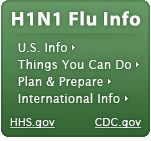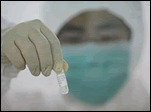CDC
Immunization Advisory Panel Recommends H1N1 Influenza Vaccine Priorities, Starting
with Pregnant Women
 | The
U.S. Centers for Disease Control and Prevention (CDC) Advisory Committee on Immunization
Practices (ACIP) has announced that certain groups should be given priority for
vaccination against novel influenza A-H1N1, also known as "swine flu."
The list starts with pregnant women, who have an elevated risk of flu-related
complications and death, according to a report in a recent issue of The Lancet.
People with compromised immune systems -- which would include those with HIV/AIDS
-- are also on the list. H1N1 vaccine candidates are now in the early stages of
development and testing. |
By
Liz Highleyman  Typical
seasonal influenza mainly poses a risk for very young and elderly people and others
with weak immune systems. The H1N1 flu,
however, has caused an unusually high proportion of severe illness and death among
older children and young adults (most of whom have had other underlying health
conditions), and in particular pregnant women. Typical
seasonal influenza mainly poses a risk for very young and elderly people and others
with weak immune systems. The H1N1 flu,
however, has caused an unusually high proportion of severe illness and death among
older children and young adults (most of whom have had other underlying health
conditions), and in particular pregnant women.
As of July 24, 2009, CDC
had received reports of 43,771 laboratory-confirmed H1N1 cases, 5011 hospitalizations,
and 302 deaths in the U.S.
 ACIP
held a meeting in July to discuss the spread of H1N1 and to determine vaccination
prioritization and implementation. When the H1N1 vaccine -- now undergoing intensive
development -- first becomes available, ACIP recommends that programs and providers
make it a priority to vaccinate the following groups: ACIP
held a meeting in July to discuss the spread of H1N1 and to determine vaccination
prioritization and implementation. When the H1N1 vaccine -- now undergoing intensive
development -- first becomes available, ACIP recommends that programs and providers
make it a priority to vaccinate the following groups:
 | Pregnant
women. |  | People
who live with or care for children younger than 6 months of age. |  | Health
care and emergency services personnel. |  | Persons
between the ages of 6 months and 24 years. |  | People
between the ages of 25 and 64 years who are at higher risk due to chronic health
disorders or compromised immune systems. |
The
advisory panel indicated that the key populations include people who are at higher
risk of disease or complications, those who are likely to come in contact with
novel H1N1, and those who could infect young infants. However, the agency's epidemiology
figures indicate that the highest proportion of deaths -- 41% -- have occurred
in people aged 25-49, followed by 24% in the 50-64 age group, neither of which
are included in the priority list unless they have other health conditions. Only
2% of deaths so far have occurred in children age 4 or younger.
Altogether,
the 5 highest priority groups comprise nearly 160 million people, which exceeds
the projected initial vaccine supply. ACIP also released a narrower list -- comprising
about 40 million people -- to be used if the vaccine has limited availability.
This list includes pregnant women, household contacts of infants younger than
6 months, a subset of health care workers and emergency personnel who have direct
patient contact, children aged 6 months through 4 years, and children aged 5 to
18 years who have underlying risk factors that put them at risk for flu complications.
ACIP recommended that health care providers continue to emphasize the
importance of regular seasonal influenza vaccination and ensure that patients
receive these vaccines as soon as they become available -- particularly people
aged 65 and older, who are not on the H1N1 vaccine priority list. "The
H1N1 outbreak so far has spared that population to a large extent," said
Anne Shuchat of the CDC's National Center for Immunization and Respiratory Diseases.
"After younger age groups have been addressed, if supply is adequate vaccination
could be offered at that time." For
more information from the meeting and the resulting recommendations, visit the
ACIP
meeting website. Pregnant
Women While
the absolute number of pregnant women severely affected by H1N1 to date has been
small, the percentage is high considering the proportion of pregnant women in
the population at any given time. As
reported in the August
8, 2009 issue of The Lancet, 6 of the 45 H1N1-associated deaths reported
to the CDC between April and June -- or 13% -- occurred among otherwise healthy
pregnant women. Furthermore, pregnant women who contract H1N1 flu are at least
4 times more likely to be hospitalized. Pregnant
women suspected of having H1N1 should receive oseltamivir (Tamiflu) as soon as
possible, even before completion of diagnostic testing, according to the study
authors.
"Testing
is not available in many instances and, when available, results of novel H1N1
testing often takes several days," according to the CDC's interim guidance
for pregnant women. "Clinicians should be aware of circulation of H1N1 in
their area and not wait for test results to initiate influenza treatment in women
who have symptoms consistent with influenza illness." "Some
clinicians hesitate to treat pregnant women with antiviral medications because
of concerns for the developing fetus, but this is the wrong approach," said
lead author Denise Jamieson of CDC's U.S. Public Health Office. "It is critical
that pregnant women in particular be treated promptly." Global
Epidemic
In
related news, the World Health Organization (WHO) in late July issued a report
estimating that the novel H1N1 flu could infect as many as 2 billion people --
or about 1 in 3 worldwide -- over the next 2 years. The virus has now spread to
all regions and almost every country, according to the agency. To
address the crisis globally -- and ensure that limited vaccine and flu drug supplies
do not all go to high-income countries -- United Nations Secretary-General Ban
Ki-Moon urged wealthy nations to help developing countries access the H1N1 vaccine
so that health workers can be vaccinated and able to keep hospitals open. During
a recent Mercosur South American trade summit, presidents Cristina Kirchner of
Argentina and Luiz Inacio Lula da Silva of Brazil proposed that developing countries
be allowed to suspend patent rights so they can produce more H1N1 vaccine than
licensed manufacturers can manage. Using patent rights to preserve an economic
advantage, said Kirchner, "would condemn millions of people to death." Pharmaceutical
company Baxter International announced on August 8 that it has completed production
of its first commercial batches of H1N1 vaccine. The same day, Novartis announced
that it has launched the first human trials of its candidate vaccine.The year-long
trial will involve 6000 people in the U.S., U.K., and Germany. While
efforts to develop, test, and produce an effective H1N1 vaccine have been put
on the fast track, the WHO emphasized that this would not compromise safety or
quality control. 8/18/09 Sources ACPM
Headlines. CDC
Advisory Panel Recommends H1N1 Vaccine Priority List. Press Release.
August 6, 2009. Kaiser
Family Foundation. H1N1 Could Infect Up To 2B People Within Next Two Years, WHO
Says. Kaiser Daily Global Health Policy Report. July 27, 2009. Kaiser
Family Foundation. Fast-Tracked H1N1 Vaccines Will Not Compromise Safety, WHO
Says. Kaiser Daily Global Health Policy Report. August 6, 2009. Reference DJ
Jamieson, MA Honein, SA Rasmussen, and others. H1N1 2009 influenza virus infection
during pregnancy in the USA. The Lancet 374(9688): 451-458. August 8, 2009. (Abstract).
|